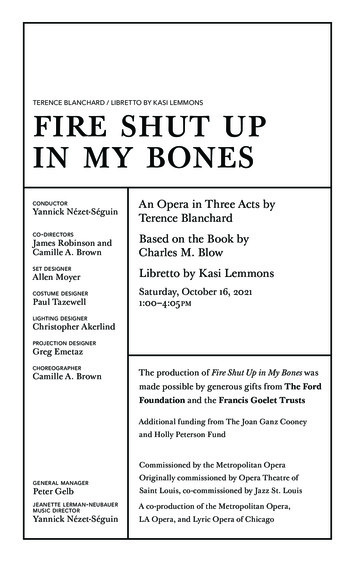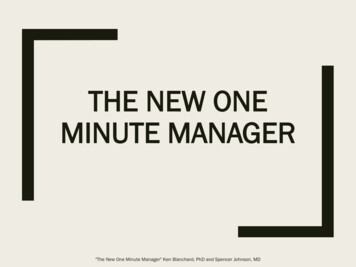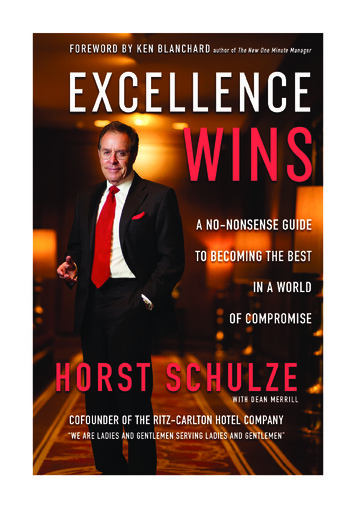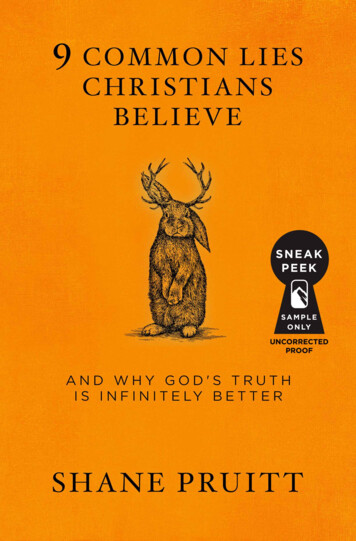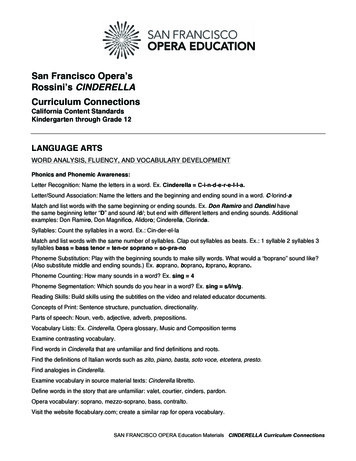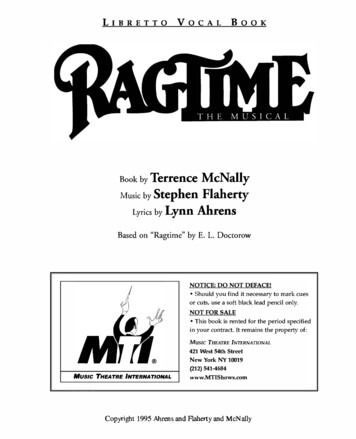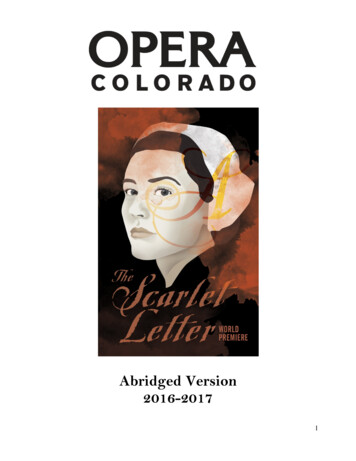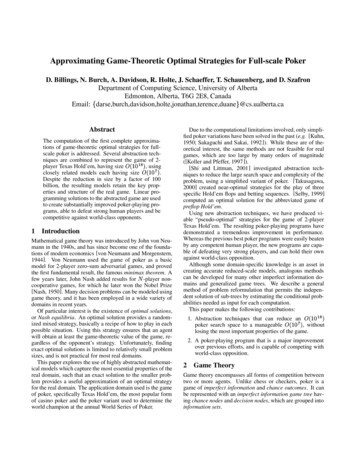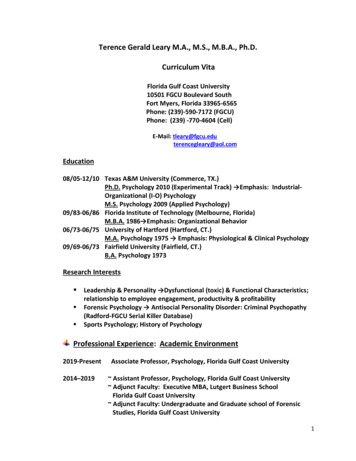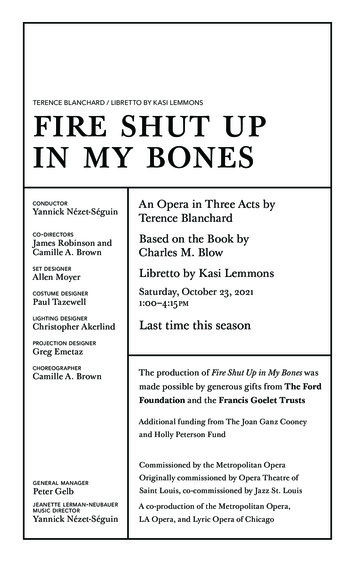
Transcription
fire shut upin my bonesTERENCE BLANCHARD / LIBRETTO BY KASI LEMMONSconductorYannick Nézet-SéguinAn Opera in Three Acts byTerence Blanchardco - directorsBased on the Book byCharles M. Blowset designerLibretto by Kasi LemmonsJames Robinson andCamille A. BrownAllen Moyercostume designerPaul Tazewelllighting designerChristopher AkerlindSaturday, October 23, 20211:00–4:15 pmLast time this seasonprojection designerGreg EmetazchoreographerCamille A. BrownThe production of Fire Shut Up in My Bones wasmade possible by generous gifts from The FordFoundation and the Francis Goelet TrustsAdditional funding from The Joan Ganz Cooneyand Holly Peterson FundCommissioned by the Metropolitan Operageneral managerOriginally commissioned by Opera Theatre ofPeter GelbSaint Louis, co-commissioned by Jazz St. Louisjeanette lerman - neubauermusic directorA co-production of the Metropolitan Opera,Yannick Nézet-SéguinLA Opera, and Lyric Opera of Chicago
2021–22seasonThe eighth Metropolitan Opera performance ofTERENCE BLANCHARD’Sfire shut upin my bonesco n duc to rYannick Nézet-Séguinin order of vocal appearancech a r l e su n cl e pau lWill LivermanRyan Speedo Green*destinyforemanAngel BlueNorman Garrettbilliech i ck en plu ck erLatonia MooreTerrence Chin-Loych a r ’ e s - b a byr u byWalter Russell IIIBriana Hunterwilliams pi n n erCheikh M’BayeChauncey Packern at h a nv er n aOleode OshotseDenisha Ballewja m e slo n el i n e s sEjiro OgodoAngel Bluer o b er tyo u n g lov elyJudah TaylorMarguerite Mariah JonesSaturday, October 23, 2021, 1:00–4:15PM
ch e s t erg r e taChris KenneyAngel Blueb er t h aCierra Byrd**pa s to rDonovan Singletary*wo m a n s i n n ero r ch e s t r a r h y t h m s ec t i o nBryan Wagorn*Matt Brewergu i ta r Adam Rogersd r u m s Jeff Wattspi a n obassBriana Huntera d u lt r o b er tCalvin Griffina d u lt w i l l i a mTerrence Chin-Loya d u lt n at h a nErrin Duane Brooksa d u lt ja m e sNorman Garrettwo m enDenisha BallewChristine JobsonJasmine MuhammadKimberli RenderNicole Joy MitchellKarmesha Peakee v ely nBrittany Reneek aboomDonovan Singletary** Graduate of theLindemann Young ArtistDevelopment Program** Member of theLindemann Young ArtistDevelopment Programpl e d g eDavid Morgans SancheznashChase TaylorSaturday, October 23, 2021, 1:00–4:15PM
This afternoon’s performance is being transmitted livein high definition to movie theaters worldwide.The Met: Live in HD series is made possible by a generous grant fromits founding sponsor the Neubauer Family Foundation.Digital support of The Met: Live in HDis provided by Bloomberg Philanthropies.The Met: Live in HD series is supported by Rolex.Chorus Master Donald PalumboDramaturg Paul CremoMusical Preparation Donna Racik, Jonathan C. Kelly, Kazem Abdullah,Bryan Wagorn*, and Katelan Tr ân Terrell*Assistant Stage Directors Christina Franklin, Rajendra Ramoon Maharaj,Daniel Rigazzi, and Paula SuozziAssociate Choreographer Rickey TrippAssistant Choreographer Maleek WashingtonAssistant Set Designer Ryan HowellAssistant Costume Designer Devario SimmonsAdditional Orchestrations Howard DrossinIntimacy Director Doug Scholz-CarlsonAssistant Intimacy Director Rocio MendezMet Titles Michael PanayosPrompter Donna RacikAdditional Casting Tara Rubin, CSA; Tasha Ward, CSASpecial Thanks Dr. Angel CaraballoScenery, properties, and electrical props constructed and painted by The Scenic Route,Pacoima, and Metropolitan Opera ShopsCostumes constructed by Metropolitan Opera Costume Department; Barak LLC, JerseyCity; John Kristiansen New York Inc., New York City; Donna Langman, New York City;Jennifer Love Costumes, New York City; and Crystal Thompson, New York CityWigs and Makeup constructed and executed by Metropolitan Opera Wig andMakeup DepartmentThis production uses gunshot effects.The commissioning and development of the world premiere of Fire Shut Up in MyBones at Opera Theatre of Saint Louis was made possible with support from the Fred M.Saigh Endowment at Opera Theatre, the Sally S. Levy Family Fund for New Works, theWhitaker Foundation, The Andrew W. Mellon Foundation, the National Endowment forthe Arts, and OPERA America’s Opera Fund.This performance is made possible in part by public funds from the New York StateCouncil on the Arts.Before the performance begins, please switch off cell phones and other electronic devices.Yamaha is the Official Piano of the Metropolitan Opera.The Met will be recording and simulcasting audio/video footage in the opera housetoday. If you do not want us to use your image, please tell a Met staff member.* Graduate of the Lindemann Young Artist Development Program
SynopsisAct ICharles Blow, age 20, drives down a Louisiana backroad with a gun in thepassenger seat. Destiny sings to him, calling him back to his childhood home.He begins reliving memories from his childhood.Charles’s seven-year-old self, Char’es-Baby, talks to his mother, Billie. Heis desperate for affection, but Billie is too frazzled to give him the validationthat he craves. They are dirt poor. Billie works in a chicken factory, but shedreams of Char’es-Baby getting a good education and escaping their town.Her husband, Spinner, is a womanizing spendthrift. When she hears that he’sflirting with other women, she confronts him at gunpoint. Billie doesn’t shoot,but she tosses Spinner out. Billie and her five sons move in with Uncle Paul.Char’es-Baby dreams of a different life, collecting “treasure” from the junkyardwhile Loneliness sings to him. One day, his cousin Chester comes to visit. WhenChester sexually abuses him, he is too horrified and ashamed to say anything.Adult Charles begins to weep as he recoils from these memories, while Destinyreminds him that there is no escape.Intermission(AT APPROXIMATELY 2:20PM)Act IIAs Charles grows into a teenager, he is full of confusion and rage, andtormented by phantom terrors. He attends a church service in which the pastoris baptizing people, promising that God can wipe all sins clean. Charles decidesto get baptized, but it fails to free him of his inner demons. Charles tries totalk to his brothers, but they refuse to engage in any “soft talk.” Lonelinessreappears, promising to be his lifelong companion. Evelyn, a beautiful younggirl, interrupts Charles’s reverie. Their chemistry is clear. Charles feels a newsense of independence and is finally ready to strike out on his own; GramblingState University has offered him a full scholarship. Billie is left alone to reflect onall that she has sacrificed for her family and wonders what might lie ahead.Act IIIAt his college, Charles rushes Kappa Alpha Psi fraternity, where the brotherslead an elaborate and energetic step dance. Charles and the other pledges arehazed, but he stoically takes each indignity in stride: Pain is nothing new for him.Later, he goes to a frat party and meets an attractive young woman, Greta. Theybegin a passionate love affair. Charles eventually shares his awful secret withVisit metopera.org.35
SynopsisCONTINUEDGreta, only to find out that she’s still seeing someone else. Charles is left aloneagain. He calls home, desperate to hear his mother’s voice. To his shock, Billietells him that Chester has come back to visit. Charles instantly decides to returnhome to confront Chester, gun in hand.Charles sits in his car on the dark road, contemplating the choice lying beforehim. Destiny starts to sing to him once again, seductively promising to standby him through to the bloody end. As Charles reaches his childhood home,Char’es-Baby appears, urging him to leave his bitterness behind. Charles mustdecide whether to exact his revenge or begin his life anew.Synopsis reprinted courtesy of Opera Theatre of Saint Louis.If you or someone you know needs support in relation to sexual abuse, contactthe Rape, Abuse, and Incest National Network at rainn.org or 800.656.4673.Great American Composers on DemandLooking for more operas created by American composers? Checkout Met Opera on Demand, our online streaming service, to enjoyother outstanding performances from past Met seasons—includinga 1966 radio broadcast of the world premiere of Samuel Barber’sAntony and Cleopatra—which inaugurated the new Met at LincolnCenter—a telecast of John Corigliano’s The Ghosts of Versaillesfrom 1992, and a Live in HD transmission of the hit 2019 staging ofthe Gershwins’ Porgy and Bess. Start your seven-day free trial andexplore the full catalog of more than 750 complete performances atmetoperaondemand.org.36
In FocusTerence BlanchardFire Shut Up in My BonesPremiere: Opera Theatre of Saint Louis, 2019Fire Shut Up in My Bones is a setting of journalist and commentator Charles M.Blow’s contemporary memoir, which deals with the author’s attempts to find loveand healing in his young adulthood after a childhood pervaded by abuse. Theabuse took multiple forms, both in the background of dire poverty of Blow’s ruralAfrican American community—embedded in the visible and unseen systems ofclass and race that perpetuated that poverty—and in a harrowing incident ofsexual trauma perpetrated by a cousin on the seven-year-old Charles (calledChar’es Baby), an act of betrayal that unleashed a years-long process of selfrecrimination and shame. As he matures, Charles struggles in relationships—with a personification of Destiny, who challenges him to consider his place in theworld; with a personification of Loneliness, who lays claims on him; with a youngwoman named Greta to whom he is attracted (all three characters portrayedby the same singer); with his other relatives and members of his community;with his church; and above all, with his mother Billie, whose love is clear but notalways available. Ultimately, he must confront the defining experience of hisown inner conflicts before he can achieve any form of self-actualization, eitherthrough revenge on his childhood abuser or through some resolution of theongoing personal crisis that it engendered. The score, by Terence Blanchard,draws on several sources—ranging from jazz to classical to the traditional musicof these rural communities—to depict internal and communal conflicts.The CreatorsTerence Blanchard (b. 1962) is a celebrated composer whose many worksexpress his roots in jazz but defy further categorization. The six-time GrammyAward winner was born in New Orleans and became a trumpeter for the LionelHampton Orchestra in 1982. His first opera, Champion, was produced in St.Louis in 2013. A prolific creator in a wide variety of forms and genres, he isespecially celebrated for his close collaboration with director Spike Lee and hisaccomplishments as an award-winning composer of film scores, including forMalcom X, BlackKklansman, Da 5 Bloods, Mo’ Better Blues, and more than 60others. Charles M. Blow (b. 1970) is a noted journalist and commentator. He isa regularly featured op-ed columnist for The New York Times and an anchor forthe Black News Channel. The libretto for Fire Shut Up in My Bones marks thefirst foray into opera for Kasi Lemmons (b. 1961), a noted writer, actress, anddirector, whose films include Harriet, Talk to Me, and Eve’s Bayou.Visit metopera.org.37
In FocusCONTINUEDThe SettingThe opera takes place in and around the small and poor town of Gibsland,in northwestern Louisiana, as well as at Blow’s alma mater, Grambling StateUniversity. The time ranges from Charles’s childhood in the 1970s to hisadulthood in the 1990s.The MusicBoth grounded in the classical idiom and deeply steeped in the form-defyingjazz that has been central to Blanchard’s output, Fire Shut Up in My Bones doesnot fit perfectly into any single category or genre. The composer’s use of filmscore techniques—including a lyrical sweep that propels the action forward andthe ability to have a sudden audio “close-up” on a given character—is a notablefeature of the score. Another element worth noting is the use of the music ofthe characters themselves and the world that they inhabit, although theserecognizable references are always a part of the overall narrative soundscape.The music associated with the church services that the struggling Charlesattends, for example, embraces the style of Black spiritual music of this regionbut is not a literal recreation. Instead, it tells the story of a character’s experiencewith that musical encounter. The vocal writing also parallels this path, composedfor singers with the power of traditional classical training but also requiring acomfort level with the methods of jazz and gospel singing. Spoken, rather thansung, passages appear briefly and with dramatic significance, and at manytimes during Charles’s flashbacks, he and his younger self, Char’es-Baby, singthe same lines in unison. The characters of Destiny and Loneliness in particularexpress themselves in music that incorporates jazz and classical traditions whilenot being entirely defined by one or the other. Charles’s mother Billie, likewise,has music that must express her great love for her family while simultaneouslyshowing her inability to express that affection. In this, her music recalls the mostcomplex and nuanced characters in the operatic repertory. Charles’s soliloquys,musicalized internal monologues that give voice to the character’s epicpsychological journey to self-acceptance, are prime examples of the score’sdemands on the performer’s skills in several diverse genres at once.Met HistoryThe first opera by a Black composer performed at the Met, Fire Shut Up in MyBones opened the 2021–22 season on September 27, 2021, as the companyretook the stage following the longest closure in its history due to the Covid-19pandemic. Music Director Yannick Nézet-Séguin conducted a production codirected by James Robinson and Camille A. Brown and starring baritone WillLiverman as Charles, soprano Angel Blue as Destiny/Loneliness/Greta, andsoprano Latonia Moore as Billie.38
A Note from James RobinsonWhen I became artistic director at Opera Theatre of Saint Louis in 2009, amongmy first priorities was to embark on a wide-ranging commissioning initiativecalled New Works, Bold Voices. The objective was to create new operasand to provide opportunities for composers to take a second look at operas theyhad already premiered. One of the first composers I contacted was jazz trumpeterTerence Blanchard. I was well acquainted with Terence’s music from his powerful filmscores, and I still consider his haunting album A Tale of God’s Will one of the bestthings in my personal music library. After our first meeting, Terence agreed to createan “opera in jazz,” and in 2013, we premiered Champion, based on the life of bisexualboxing champ Emile Griffith. The success of Terence’s opera was tremendous, so Iimmediately asked him to follow it up with another. Fire Shut Up in My Bones waspremiered in 2019 in St. Louis, and, yet again, it was met with great enthusiasm.Both of Terence’s operas deal fearlessly with Black men struggling with their identityand sexuality, in addition to confronting some very difficult and often painful subjects.The story of Emile Griffith is told through the fog of pugilistic dementia and confrontsthe athlete’s search to embrace his love of other men. As Emile sings in the opera(after being haunted by the death of an opponent he killed during a bout): “I kill aman, and the world forgives me. I love a man, and the world wants to kill me.” CharlesM. Blow’s elegant and gripping memoir Fire Shut Up in My Bones reveals a manhaunted by the abuse he suffered at the hands of an older cousin and how coming toterms with his own sexuality became a lifelong journey. And while not everyone hasexperienced the reality of growing up poor in rural Louisiana, Blow’s memoir toucheson universal themes that are both resonant and relevant. In both operas, an honestlight is shone on taboos, social norms, and stereotypes. And what I find particularlymoving is how Terence uses music to give these characters compelling voices.In the opera, Charles is faced with a brutal choice and looks back on his life tounderstand what has led him to a potentially life-ruining crossroads. He questions hisrole in certain traumatic events and wonders how he could have changed the course ofhis own personal history. His is a journey of self-loathing, self-discovery, and eventuallyself-forgiveness. Charles states that he is a “stranger in my hometown,” and I find thisidea deeply affecting, for many of us have felt the loneliness of not fitting in or notbelonging, even in an environment that should be comforting and familiar.While preparing Fire Shut Up in My Bones, first in St. Louis and now at the Met, oneof the challenges was how to adapt Kasi Lemmons’s gorgeously cinematic libretto tothe stage. Early on, Kasi and I talked about how a memoir is like a collection of oldphotographs. With that in mind, the creative team and I—now joined by co-directorand choreographer Camille A. Brown, with whom I had the immense honor of workingwith on Porgy and Bess—set out to create a fluid, multi-layered, almost collage-likeproduction. I cannot say enough about how thrilled I am to be involved in this historicproduction at the Met and to work with this extraordinary composer, librettist, and cast.—James RobinsonVisit metopera.org.38A
A Note from Camille A. BrownContributing my voice to Terence Blanchard’s beautiful and hauntingmusic, creating movement language for Kasi Lemmons’s libretto,sharing the story of celebrated writer Charles M. Blow, and co-directingwith James Robinson, with whom I had the pleasure of working on Porgyand Bess, has been a dream. It has also been uniquely challenging becauseI joined the Fire Shut Up in My Bones project at the height of the pandemic,five years after work began on the original production. Not only did I have tochoreograph, I had to find my directorial voice, among a team that had beencollaborating for years. It was daunting, thrilling, and overwhelming to playcatch-up. I started with what I know—dance—and approached the piece thesame way I approach all of my creative work, asking questions, investigating,and listening. How could I make sure that the gestures and movements stayedtrue to the intentions of the composer? How could my direction amplify thevoice and the heart of this piece?In the director’s seat, I wanted to play with abstraction and time travel,capturing the psyche of Charles, his inner turmoil, and his tussles with Destinyand Loneliness. We treated each scene as though it were one of those agedPolaroid pictures—static in time, with the only breath being Charles, walking usthrough his journey, the pictures shapeshifting as we follow him along. Isolatedboth spiritually and physically, it was important to show Charles’s struggles, hislonging for peace, and his search for a savior—only to realize that his savior washimself, the younger version of himself, giving him grace and resolve.Two phrases within the show resonate with me: “Sometimes you gotta’ justleave it in the road” and “I bend , I don’t break, I sway.”They speak to the specificity of the Black experience but also call upon auniversal theme of determination and the need for personal resolution. Charlesexperienced a traumatic childhood event, which changed his life. He ultimatelyfinds the strength and motivation to “leave it in the road.” Past traumas caneither haunt us or heal us. Charles’s story empowers us with the understandingthat the devastation of the past does not have to define our futures. We too cangive ourselves the grace to let go. Fire also illuminates themes of perseveranceand resilience—both hallmarks of the Black experience. We don’t break, wesway. We never give in. Our light will never go out. To honor this, I wanted tofind a way—amid the struggle—to elevate the stuff of the Black experience thatcelebrates us. That heals us. That shows us off.Terence has created a percussive score that is complex and nuanced, and Ihave tried to add to that my original artistic expression in movement, bringingto bear the many influences and elements that make up my individual style.What I found so thrilling was that I could use step to embody triumph, pain, andthe joy of life, and create a rhythmical score for this powerful “opera in jazz.”Step is a social dance rooted in African American history and culture, tracingback more than 200 years to West Africa, transformed by enslaved people38B
throughout the Americas. Stepping is energetic, visceral, urgent, and powerful.It is also embedded in the fabric of Black fraternities and sororities, which wereintentionally created as safe spaces when white Greek-letter organizationswould not let Black men and women join them. It has always been historicallyimportant for Black people to create safe spaces for themselves. What hasemerged from that has been extraordinary: Black people creating communityfor themselves everywhere—in the Church, at the jook joint, and at historicallyBlack colleges and universities. In these safe spaces, we converge to share allthat is messy and radiant in our lives, in our relationships, and in our humanity.I am humbled and honored to be a part of this show that is inviting audiencesinto a vulnerable and poignant story.At one point in history, Black people were not allowed to perform on theMet stage and even more so, were not able to authentically portray our ownnarratives. The full spectrum of our real lives were unseen. But we did not break.Once invisible, now beautifully and vibrantly visible. Past, present, and future,we sway.—Camille A. BrownVisit metopera.org.38C
The Contributions and Complications ofBlack Fraternities and SororitiesBlack fraternities and sororities are significant in the African Americancommunity, with the cultural and service-oriented tenets acting as strongreasons that individuals join. In the early 1900s, America was a placewhere Black people were looking for spaces to fit in. Black college studentswere looking for others with relatable challenges to bond and organize with forindividual and collective success. There were few avenues for educated Blackpeople to come together for service to their people and community until thesefraternities and sororities emerged.The founding of these organizations was influenced and rooted in a legacyof trauma and hurt—hurt that was carried by individuals who were in the samegeneration as families raised in the antebellum South under Jim Crow. Theyall promote higher education as a means to elevate their people. They alladvocate for closing wealth and healthcare disparities, civil and voting rights,affordable housing, criminal justice reform, and jobs with living wages, andthey all believe in robust community service and mentoring. But, as we see inFire Shut Up in My Bones, they also were all plagued with unsanctioned andunfortunate occurrences of hazing.Charles Blow and I were drawn to the same fraternity—Kappa Alpha Psi—presumably for the same reasons: the mission of achievement, the idea ofbrothers who stand together and stand up for one another, and the comfortof men who would befriend and never betray. Kappa gave us leaders androle models to emulate. In fact, most Black men doing significant things weremembers of a Black fraternity. These associations help raise the bar for whatone can accomplish, especially against overwhelming odds.Navigating America as a Black man or woman presents a unique set ofchallenges which are marginally mitigated by joining a fraternity or sorority. Forme and Blow, it became important to have the support and encouragementof a group of people who also aspired to be leaders and change agents. Thepotential of being hazed seemed a small price to pay for this bond and legacyof strength and community. Because of this rationale, pledges and brothersgenerally attributed honor and heritage to the legacy of hazing and were eachtrained to teach the same to those who followed. And therein lies the cycle ofa historic and horrific mentality that has left a black eye on the great characterand value of fraternities and sororities, otherwise amazing treasures in theBlack community.I recall similar instances of hazing in pledging Kappa as those depictedin Blow’s memoir and Terence Blanchard’s opera. The questions Blow askedhimself, I asked myself. The conflicting emotions that he experienced alsosurfaced within me. Sadly, after more than 30 years as a brother, I still find myselftrying to balance, equate, and weigh the good versus the brutal and bad.Blanchard’s opera shows that every individual brings their own stories,traumas, and experiences with them to college and to fraternities or sororities.38D
How they are shaped, formed, and realized will be different for each individual.For me, pledging was not the highlight of the fraternal experience. I appreciatethat the opera brilliantly captures the beautiful traditions of stepping andline dancing in celebration of a rich history of achievement. My memoriesalso involved challenges that shaped me into the man I am today. Not onlydid it prepare me for the rigors of being a Black man in America, but it alsohelped me see all the possibilities that can be achieved through hard workand perseverance. These are the same challenges that Blow faced during theprocess of joining a fraternity, as well as the general history of Black peoplelearning to rise above the surrounding circumstances. I am proud that ourfraternities today are exercising safer, legal ways to create bonds that uplift thenext generation of Black leaders in America.—Sean PittmanSean Pittman is an alumnus of Kappa Alpha Psi’s chapter at Florida StateUniversity, where he earned bachelor’s and law degrees and was student bodypresident. A prominent attorney, philanthropist, and host of The Sean PittmanShow and podcast, he is past president of the Orange Bowl Committee andGeneral Counsel of the National Bar Association.Visit metopera.org.43
Angel Blue and Eric Owens return thisseason in the Gershwins’ Porgy and Bess.KEN HOWARD / MET OPERAMAKE THE2021–22 SEASONYOUR OWNMake the most of the 2021–22 season, which features six newproductions—including four Met premieres—and 16 popular revivals.You can save up to 15% and receive exclusive benefits when you builda Flex Subscription package of six or more operas, or up to10% with a Create Your Own series of three to five performances.Learn more at metopera.org/tickets.
The Cast and Creative TeamTerence Blanchardcomposer (new orleans , louisiana )Shut Up in My Bones marks Terence Blanchard’s Met debut and ishis second opera, following the 2013 Champion. Both works had their world premieres atOpera Theatre of Saint Louis, and Fire Shut Up in My Bones will also appear at Lyric Operaof Chicago later this season. He studied jazz trumpet at Rutgers University and was invitedto play with the Lionel Hampton Orchestra in 1982. Following a string of collaborativerecordings, he released his first, self-titled solo album on Columbia Records in 1991,and in 2015, he released his first album with his jazz quintet E-Collective. His extensivefilmography includes the scores for more than 60 films, and he frequently collaborateswith director Spike Lee, including on the recent BlacKkKlansman and Da 5 Bloods, forwhich he was nominated for Academy Awards. He also scored the recent HBO seriesPerry Mason. Among his other numerous accolades are six Grammy Awards (from 14nominations), BAFTA and Golden Globe Award nominations, and a 2018 United StatesArtists fellowship.career highlights FireKasi Lemmonslibrettist (st. louis , missouri)screenwriter-director, actor, producer, and librettist KasiLemmons is one of the most impactful voices of our time. For decades, her storytellinghas brought the African American experience to the fore—taking audiences from thecomplex social world of Louisiana’s intelligentsia in her first feature, Eve’s Bayou, recentlyadded to the Library of Congress’s National Film Registry; to the streets and airwaves ofVietnam-era Washington, D.C., in Talk to Me, which won her an NAACP Image Awardfor outstanding directing; to the treacherous Southern fields and freedom-promisingNorth in Harriet, starring Cynthia Erivo as the iconic liberator Harriet Tubman, which wasnominated for two Oscars. Fire Shut Up in My Bones is her first opera libretto and is thefirst opera with a Black librettist to be performed by the Met. She is an arts professor in thegraduate film department at NYU and is currently directing the Whitney Houston biopic IWanna Dance with Somebody while developing the feature The Shadow King, based onthe novel by Maaza Mengiste, and the television series Ring Shout, based on the novelby P. Djéli Clark.career highlights Award-winningVisit metopera.org.45
The Cast and Creative TeamCONTINUEDCharles M. Blowauthor (gibsland, louisiana )M. Blow has been an op-ed columnist at The New York Timessince 2008. He is also host of PRIME with Charles Blow on the Black News Channel. He isthe author of the New York Times best-selling memoir Fire Shut Up in My Bones, whichwon a Lambda Literary Award, the Sperber Prize, and made multiple prominent lists ofbest books published in 2014. People called it “searing and unforgettable.” His mostrecent book, The Devil You Know: A Black Power Manifesto, was published in September2021. He joined The New York Times in 1994 and worked there as a graphics designer andart director before taking up the role of art director at National Geographic in 2006. Beforegoing to the Times, he worked as a graphic artist at The Detroit News.career highlights CharlesYannick Nézet-Séguinconductor (montreal , canada )this season Fire Shut Up in My Bones, Matthew Aucoin’s Eurydice, Tosca, Le Nozzedi Figaro, Don Carlos, Mahler’s Symphony No. 2, and Verdi’s Requiem at the Met; MetOrchestra Concerts at Carnegie Hall; Das Rheingold in concert with the RotterdamPhilharmonic Orchestra in Paris, and concerts with the Philadelphia Orchestra, OrchestreMétropolitain, and Rotterdam Philharmonic Orchestra.met appearances Since his 20
in my bones general manager Peter Gelb jeanette lerman-neubauer music director Yannick Nézet-Séguin An Opera in Three Acts by Terence Blanchard Based on the Book by Charles M. Blow Libretto by Kasi Lemmons Saturday, October 23, 2021 1:00-4:15 pm Last time this season The production of Fire Shut Up in My Bones was
